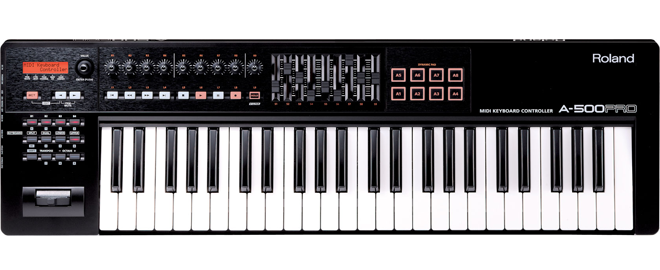A Look at Construction, Features and More
Tips for selecting the right MIDI keyboard controller.
These days MIDI keyboard controllers are an integral part of production and essential for playing software synths in the studio or on stage.
Don’t accept anything less than what you’d expect from a quality hardware synthesizer. A MIDI controller doesn’t have to be complicated, feel cheap, or play like a toy.
Here are some tips to help you make an informed decision when selecting the right MIDI keyboard controller for your needs.
Contributed by Roland US Team
1. Feel / Playability…
Too often the playability of a MIDI controller is overlooked. Just because it’s a controller doesn’t mean it has to feel and play like a toy. You’ll need good, reliable action to get the most from your sounds and to impart passion and expression into your performances.
Tip: Go to your local music store and compare the feel and playability of your favorite synth or piano to that of the MIDI keyboard controller that you are considering. Make sure it feels like an instrument and not like a toy.
2. Lots of Controls…
It’s a controller after all, so you’ll want a wide range of precise controls to tweak your sounds and control your DAW and soft synths.
Tip: Print out a copy of your digital workspace next time you go to the music store. Visualize how the MIDI keyboard controller that you are interested in fits into your workflow. Do you need knobs, sliders, pads and transport control? If yes, how many of each?
3. Quality Construction and Durability…
Whether it’s hours of playing in the studio or traveling the world on tour, a good MIDI controller needs to stand up to the rigors of the road and intense, extended jam sessions.
Tip: How solid is the MIDI keyboard controller? Could it take your everyday use? How about abuse?
Netsky‘s live band setup consists of an A-500PRO played by Netsky himself and an A-800PRO played by Babl among other gear.
4. Quality Drivers…
A MIDI Controller won’t be much fun to use if it’s crashing your software or messing with your timing. A controller might look great on the surface, but if its driver is sub-standard, it can cause instability, intermittent connections and other anomalies.
Tip: Do a little research on the manufacturer that you are considering. What’s their history in developing fast, stable drivers that do their job so you can do yours?
5. Software Integration…
It’s important to have extensive control over your software, whether it’s a virtual instrument or your DAW.
Tip: A MIDI keyboard controller that has customizable and configurable controls (knobs, sliders, pads, etc.) is ideal. In most cases, a controller with native support from your DAW dynamically maps controls depending on the virtual instrument or effect on your screen.
Roland MIDI Keyboard Controllers…
Roland is no stranger to building classic, road-worthy instruments, and Roland’s MIDI keyboard controllers are no exception. They are built to the same standards and with the same care as Roland’s other professional instruments. Rest assured; they are up to the task.
Obviously, there are many other features and things to consider when selecting the right MIDI keyboard controller. What would you add to this list?




